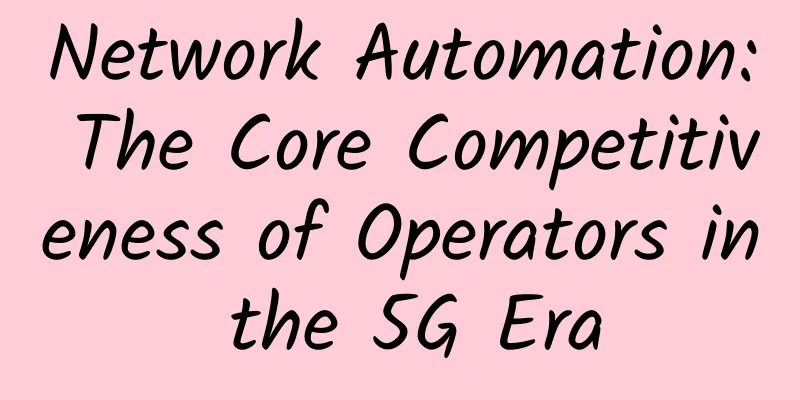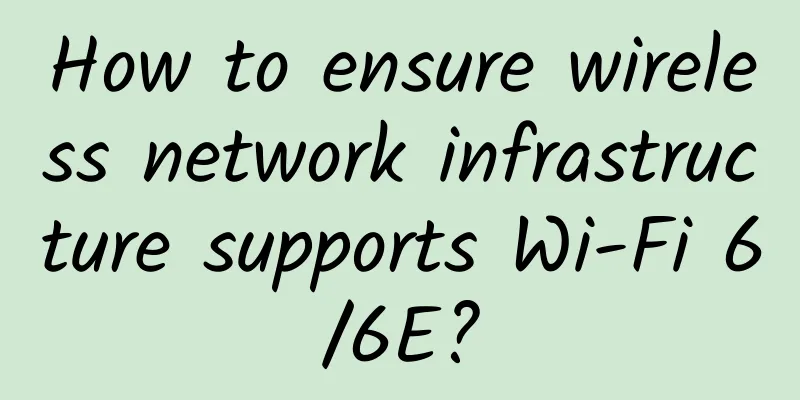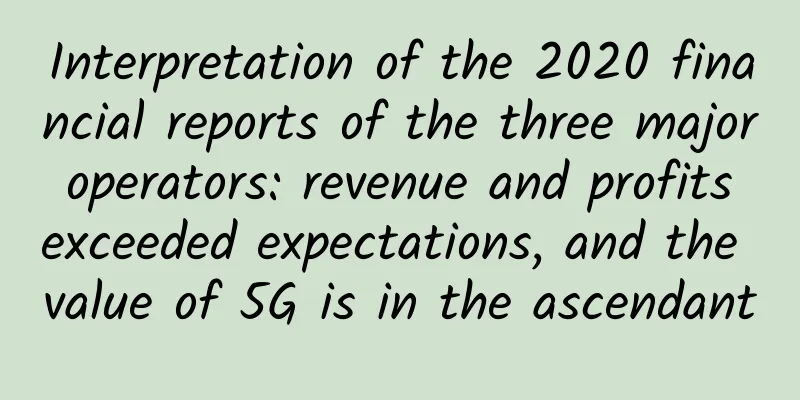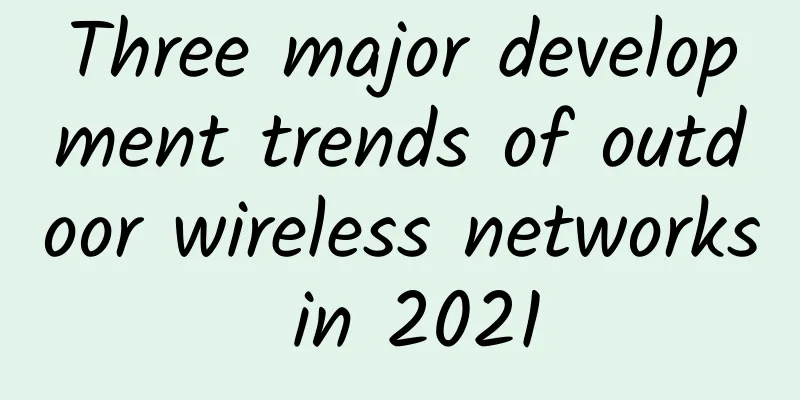Network Automation: The Core Competitiveness of Operators in the 5G Era

|
What is the core competitiveness of operators in the 5G era? It is generally understood that in the 5G era, the extensive use of white box switches, edge computing, network slicing, NFV and other technologies can save hardware costs and increase revenue. However, the value brought by these white box and virtualization technologies is actually determined by the industrial chain, not the core competitiveness of the operators themselves. Network automation is different. Japan's Rakuten Mobile adopts a highly automated management method. Its network team has only 130 people, but it provides mobile communications covering all of Japan; AT&T in the United States has spent nearly 10 years to improve the automation of the core network and access network, saving up to 50% of operating costs. It can be seen that the improvement of operational efficiency is the key to each operator itself, and the core competitiveness behind it is network automation. How to understand network automation A typical automation system is as above, the controller outputs control logic, the actuator performs specific operations on the controlled object, and the sensor collects data for closed-loop feedback. If the controlled object is a specific network, then its automatic control system can be abstracted as follows: Specifically, network automation includes the following levels: 1) Configuration management automation: The executor automatically configures physical and virtual network devices through API or CLI. Most SDN controllers in the industry have achieved this level of capability. In particular, it should be noted that most SDN controllers are not controllers in network automation, but only executors. 2) Business orchestration automation: The orchestration unit in the controller converts the business language into network configuration and then calls configuration management automation to realize automatic business changes. 3) Operation and maintenance diagnosis automation: The diagnostic unit in the controller automatically locates network faults by analyzing the monitoring data of the sensors, and then calls for configuration management automation. Network automation is a complete closed-loop system that needs to be built according to different business scenarios and operation and maintenance systems, rather than just implemented for specific devices. If you don’t fully understand the system principles of network automation, you won’t be able to guide the system implementation in actual work. How to achieve network automation Whether it is operators such as Rakuten and AT&T, or Internet companies such as Google and Alibaba, their full network automation systems are self-developed. Although it takes several years, the benefits are huge and ultimately constitute their core competitiveness in the industry. Although the 5G era will last for 10 to 15 years, due to the complexity of network automation systems, it usually takes several years to develop and test, so each operator needs to accelerate the promotion of its own network automation practices. Since 5G networks use a lot of cloud computing technology, it seems that cloud platform software can be used to achieve 5G network automation. In fact, this is not the case. For example, although network slicing in 5G is similar to VPC (virtual private network) in public cloud, the purpose of VPC in public cloud is to isolate tenants, while the goal of slicing in 5G is QoS guarantee, and its control requirements are obviously much higher. It is not enough to copy it. Due to the length of this article, the specific implementation of the network automation system in 5G cannot be described in detail. Here are two key design principles for reference. Principle 1: Bottom-up 5G network is a rapidly evolving complex system. Therefore, conventional top-down design principles are unlikely to have a practical effect and may even cause loss of control. The stability of the bottom-level automation should be ensured first, and then the higher-level automation should be built. At the same time, due to the large number of bottom-level devices and high labor costs, the benefits of achieving bottom-level automation will be greater, while top-level automation is more about intelligent decision-making, which is suitable for people to complete in both the short and long term. To get something from nothing, control must rest at the bottom within simplicity. -- Kevin Kelly The industry's earliest large-scale network automation system is Google G-WAN, which can provide specific QoS guarantees for different services on Google's global data center interconnection network. A deeper study of the system reveals that its complexity lies not in the top (globally unique) scheduling system (TE), but in the underlying (13 data centers) OpenFlow switch cluster. Most of the controller software is derived from open source platforms, but it is very difficult to achieve high availability and fault tolerance. However, once the bottom-level automation is completed, even if the top-level scheduling system fails, the entire G-WAN can still run smoothly. Therefore, the bottom-up design principle is the prerequisite for achieving large-scale network automation. Principle 2: Deep openness The open network usually mentioned is mainly the standardization of functions and APIs. However, for a complex network like 5G, it is not enough to achieve network automation by simply opening up the API level. What is needed is the APP level, that is, the OS of the network device can run third-party APPs like Windows or Android. For example, can the switches used in 5G be programmed in the data plane using the P4 language? Can third-party XDP applications run on the servers in the MEC edge cloud? The ability to be deeply open is based on the operating system kernel technology. If the network operating system cannot be mastered, then deep openness will only be the core competitiveness of equipment vendors rather than operators. A system that lacks deep openness can only achieve automation at the API level, that is, automation of the management plane, but cannot achieve automation of the control and data planes. The value of deep openness is huge and is the guarantee for achieving business automation. In the past, VMware could run F5's load balancing products on its own ESXi; now, AT&T can run VMware's SD-WAN products on its self-developed Flexware system. Compared with domestic network operating systems, almost all of them are open only at the API level, making it difficult to run third-party control and data plane apps. Although Yunshan Networks is a leader in the 5G wireless field, if the network operating system does not have the ability to be deeply open, it will inevitably cause the entire 5G technology and business ecosystem to lag behind in the long run. In summary, network automation is the core competitiveness of operators in the 5G era. This requires several years of time and a lot of manpower, and requires technical innovation and engineering practice based on the principles of bottom-up and deep openness. The prospects of 5G are bright, but the real killer applications have not yet appeared, and its industrial ecology is not yet mature. Now is a good time for operators to invest in technology to build core competitiveness. |
>>: Knowledge literacy in the 5G era: Understanding the Internet of Things
Recommend
4G is a knife, and 5G is a Swiss Army knife?
[[189173]] If the 4G network is a knife that can ...
HPE Aruba Networking: IT leaders lack awareness of how networking can enhance the employee experience
At present, the demand for hybrid office continue...
Denodo announces product launch in China through AWS Marketplace
Beijing, June 8, 2021 - Denodo, a leader in data ...
spinservers: 100M-1Gbps unlimited traffic servers starting from $118/month, Silicon Valley/Dallas data centers
spinservers launched its first promotion after th...
[11.11] LOCVPS top up 100 yuan and get 10 yuan, all hosts are 60% off, Hong Kong VPS monthly payment starts from 22 yuan
LOCVPS officially announced the promotion during ...
Do you understand the benefits of 5G? Learn about the pros and cons
We talk about 5G every day, but do you know what ...
The future of 5G technology: a world of infinite possibilities
The tech world is abuzz with something really exc...
The first "government cloud" platform in our province was launched in Xinzhou
Recently, with the "Xinzhou Public Trading P...
Do you know how to debug Modbus protocol?
[[386743]] The Modbus protocol adopts master-slav...
5G is more complex than you think
In the future, 5G networks are developing in the ...
Hubo Technology uses technology to empower content innovation and create touching content products
Recently, Chen Ye, founder and CEO of Hubo Techno...
Detailed explanation of TCP packet sticking, packet unpacking and communication protocol
In TCP programming, we use protocols to solve the...
RackNerd New Year Promotion, KVM in Los Angeles/Seattle/San Jose and other computer rooms starts at $9.89 per year
As Christmas and New Year are approaching, RackNe...
RAKsmart popular cloud server 10% off annual payment from 79 yuan, bare metal cloud/RAK Cloud/VPS 30% off, Hong Kong/Japan/Los Angeles/San Jose data center
RAKsmart also offers substantial discounts on var...
How will 5G affect our lives?
5G is slowly rolling out in many countries around...









